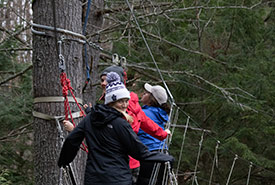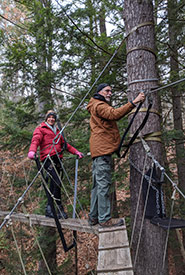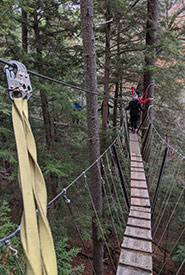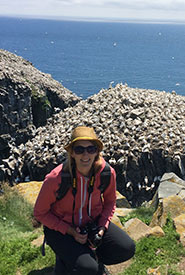Way up in the trees

NCC staff carefully balancing their steps on the canopy boardwalk at Haliburton Forest and Wild Life Reserve (Photo by NCC)
The Nature Conservancy of Canada's (NCC's) Ontario regional staff visited the Haliburton Forest & Wild Life Reserve in October 2019 as part of a staff conference focused on shared learning and team building. And what better way to bond with your coworkers than by taking a walk in the tree canopy, 10 metres above the forest floor!
At over half a kilometre long, the canopy walkway at Haliburton Forest & Wild Life Reserve is touted as the longest canopy boardwalk of its kind in the world. We eagerly put our harnesses on and listened to a safety talk before pairing up to take on the trees.
Related content

Forest canopy walkers reach the end of a walkway section and transfers their caribiners to the next section's cables. (Photo by NCC)
Our guide recommended that each pair consist of a short and a tall partner, and at first we weren’t quite sure why. Once we got up the ladder onto the first walkway, we quickly realized it was going to be a real team effort to navigate the cable system!
The walkway is divided into 26 sections of wood planks that meander through the canopy, all while you are double harnessed onto the cables above. At the end of each plank section, we carefully reached around massive trees to transfer our carabiner to the next section of cable. This is where being the tall partner came in handy. Some of the cable transfers were quite high up, and we had to work together to transfer all four of our carabiners over. We also communicated clearly to ensure we were always each secured by at least one carabiner.

The canopy walk was a great team-building exercise for NCC staff. (Photo by NCC)
Putting our trust in each other when we were up in the air is great way to get to know a fellow team member. Along the way, we had great views and an up-close-and-personal look at the top of the forest canopy.
The forest was filled with eastern hemlock, white pine, American beech and red oak trees. Although most of the deciduous trees had dropped their leaves already, some of the oak and beech leaves were hanging on and still offered a fleeting display of fall colours.
American beech and oak trees are known to hold onto their dead leaves until the following spring, a process called marcescence. It is not fully understood why some trees hold onto their leaves longer than others, but a few theories exist, including preventing the leaf bud from drying out in winter or acting as a delayed source of nutrients to the roots when the leaves fall in the spring. It is thought that the tree branches, with the extra weight of the leaves, could break more easily with snow fall, and perhaps the leaves offer a bit more shelter for birds seeking refuge in the winter. Whatever the reason, the next time you take a winter walk in the woods, take a closer look at the trees around you. You may be surprised to see how many are still hanging on to their leaves.
The canopy walk was a great team-building exercise. It was also an excellent learning experience for us ecology-minded folks, as it gave us a chance to take a closer look at some of the natural processes that take place in the forest as one season transitions to the next.


